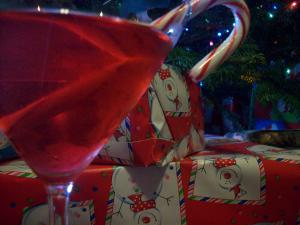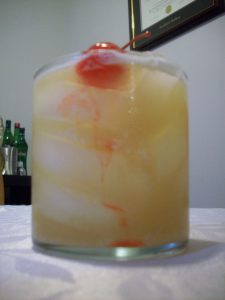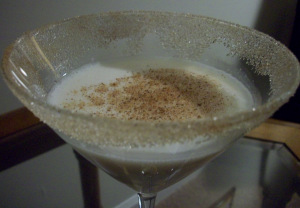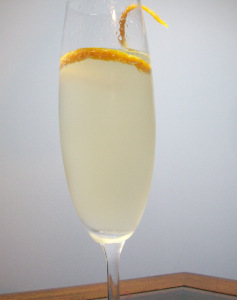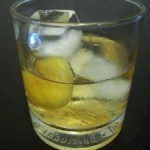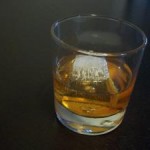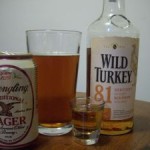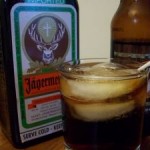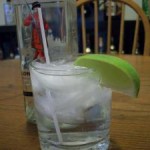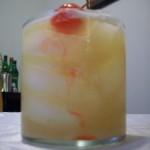Hello, fellow imbibers. This week at Six Drinks Too Many, we are sophisticated. Refined, even.
That’s because this week we’re drinking that infamous green spirit known as absinthe. Absinthe only became legal in the United States in 2007 after a ban that lasted nearly a century. You see, back in the day, it was believed that absinthe caused mental problems — it would ruin your life and make you insane. People believed that the wormwood in absinthe was to blame, and thus it was banned.
However, today we know that the mind-degrading effects of absinthe were most likely thanks to heavy metal poisoning resulting from poor distillation processes of mass-produced absinthe. It turns out that if it’s well-made, absinthe is no more dangerous than any other alcoholic beverage — luckily for aesthetic purposes, its dark reputation survives.
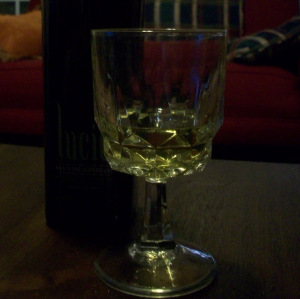 Today it’s possible to buy true absinthe in the United States. Well, sort of, anyway. Legally speaking, an absinthe sold in the United States must be free of thujone, a constituent of wormwood. Thujone was the chemical blamed for the psychoactive effects of absinthe — though it is an extremely unlikely culprit. However, because of this rule, some people will tell you that absinthe without thujone is not true absinthe. On the other hand, though, wormwood itself is a completely legal ingredient, and can be included without breaking the legal limit on thujone. Wormwood has even been added to some absinthe substitutes since the ban was lifted. Chances are that only absinthe connoisseurs will care about whether their drink has thujone or not, and even then, this law isn’t enforced very well.
Today it’s possible to buy true absinthe in the United States. Well, sort of, anyway. Legally speaking, an absinthe sold in the United States must be free of thujone, a constituent of wormwood. Thujone was the chemical blamed for the psychoactive effects of absinthe — though it is an extremely unlikely culprit. However, because of this rule, some people will tell you that absinthe without thujone is not true absinthe. On the other hand, though, wormwood itself is a completely legal ingredient, and can be included without breaking the legal limit on thujone. Wormwood has even been added to some absinthe substitutes since the ban was lifted. Chances are that only absinthe connoisseurs will care about whether their drink has thujone or not, and even then, this law isn’t enforced very well.
For the record, I consider a product in the absinthe category to be a true absinthe if it is a distilled spirit (as opposed to a liqueur, as is the case with most absinthe substitutes), has a high alcohol content (preferably above 60%), and contains wormwood. But if you’re one of the ones that needs that thujone, more power to you.
For the record, for all of these cocktails you can use an absinthe substitute such as Pernod or Herbsaint. It really depends on what you can get — but using real absinthe certainly has a unique appeal.
So, without further ado, let’s start drinking already.
Contents
Absinthe Drip
- 1 to 3 oz Absinthe
- 4 to 6 oz Ice-Cold Water
- Sugar Cube
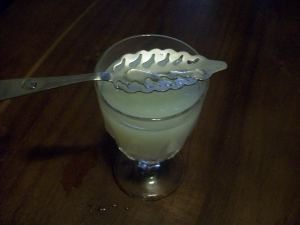 This is the classic absinthe drink, clothed in ceremony and surrounded by mystique. Many of history’s greatest creative minds have been known to indulge in this classic cocktail — and perhaps it even lead to the demise of a few of them. Or at least their ears.
This is the classic absinthe drink, clothed in ceremony and surrounded by mystique. Many of history’s greatest creative minds have been known to indulge in this classic cocktail — and perhaps it even lead to the demise of a few of them. Or at least their ears.
If you want to taste absinthe, this is the way to do it, at least to start out. It capitalizes on the unique anise flavor of the spirit, but dilutes it in a way to make it palatable to most people. The mouth feel is also very interesting; it’s almost fuzzy, in a way. And the cloudy white appearance is elegant and beautiful. Drinking an Absinthe Drip is an experience unlike any other.
Speaking as someone who isn’t all that big on anise, this is really a fantastic drink if made with a quality spirit. Even if you’re skeptical, it’s worth giving it a try if you’re interested at all in absinthe. And chances are that if you drink, you’re interested in absinthe.
Start by putting the absinthe in an ornate chalice (any glass will do, actually, but something elegant and refined is more appropriate). Then lay a perforated absinthe spoon across the top of the glass (you could use a regular fork if can’t find the traditional spoon, but it might look like something so tacky even Lady Gaga wouldn’t wear it). Put the sugar cube on the spoon and slowly pour the water over it so that it dissolves and drips into the glass. When you’re done, remove the spoon and enjoy.
The sugar cube, by the way, is a relic of when liquors were poorly made and far too harsh to drink straight. If you prefer, you can skip it when using one of today’s quality absinthes. But the water is still a good idea. The alcohol content of absinthe can get as high as 75%, and diluting it makes it a better drink, at least when starting out.
Next drink!
Sazerac
- 1/2 tsp Absinthe
- 2 oz Rye Whiskey
- 1 tsp Simple Syrup
- 4 dashes Peychaud’s Bitters
- Lemon Twist
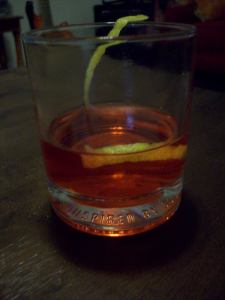 Here we have the New Orleans classic and cousin of the Old Fashioned. It’s interesting in that it uses absinthe more for its aroma rather than for its flavor. Of course, you also get a good amount of anise flavor from the bitters, along with some nice cherry and fruity notes.
Here we have the New Orleans classic and cousin of the Old Fashioned. It’s interesting in that it uses absinthe more for its aroma rather than for its flavor. Of course, you also get a good amount of anise flavor from the bitters, along with some nice cherry and fruity notes.
Speaking of flavor, the rye does things that would not be possible with other whiskeys. It’s spicier, and almost scotch-like in this context. It’s not bad, but I think I’d prefer it with bourbon. However, tradition calls for rye, and so I use rye. But, perhaps I should also be doing away with tradition — I mean, slavery was tradition, too, and that wasn’t very cool.
This isn’t a drink for everyone. If you don’t like strong whiskey drinks, you won’t like this. If you do like strong whiskey drinks, though, then this can be a fantastic libation.
When making it, start by rimming an old fashioned glass with the lemon twist, and then set the twist aside. Then rinse the glass with the absinthe. To do this, put the absinthe in the glass and slowly turn the glass around so that the absinthe coats the inside. Discard any excess absinthe and put the glass in the freezer.
Then stir the rye, syrup, and bitters with ice until cold, and then strain into the prepared glass. Twist the lemon peel over the drink and drop it in.
Moving on!
Corpse Reviver
- 3/4 oz Gin
- 3/4 oz Lillet Blanc
- 3/4 oz Cointreau
- 3/4 oz Lemon Juice
- 1 dash Absinthe
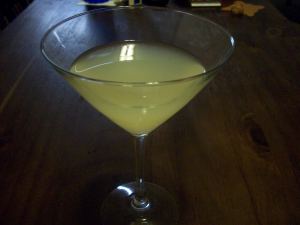 Corpse Revivers are a group of drinks that were invented because of the (incredibly stupid) idea that you can cure a hangover with more alcohol. There are a lot of different drinks that claim the name, many of which have been lost to history. This is one of the ones that has survived. This is also one which happens to use absinthe, so here we are!
Corpse Revivers are a group of drinks that were invented because of the (incredibly stupid) idea that you can cure a hangover with more alcohol. There are a lot of different drinks that claim the name, many of which have been lost to history. This is one of the ones that has survived. This is also one which happens to use absinthe, so here we are!
In keeping with the name, this drink is surprisingly refreshing if you chill it well enough. And even though it might seem like something that some enterprising and misguided college freshman might mix together with whatever liquors they managed to get their hands on, the ingredients actually work quite well together. The gin an Lillet make a nice, martini-like base, while the absinthe creates an interesting dynamic with the orange and lemon flavors. This drink is surely unique and worth a try. Plus, the name is reminiscent of zombies, and that’s pretty cool. Cooler than whatever that college freshman would call it, anyway.
By the way, it might seem like a small amount of absinthe, but keep in mind that anise is one of those incredibly strong flavors that will overpower all of the other flavors in a drink if you let it. Really, a dash will do you.
So, stir the ingredients with ice and strain it into a martini glass. Be on the look out for zombies and other ghouls while you drink it.
Now, in honor of every college freshman, let’s drink something with nothing but alcoholic ingredients in it.
Earthquake
- 1/2 oz Whiskey
- 1/2 oz Absinthe
- 1/2 oz Gin
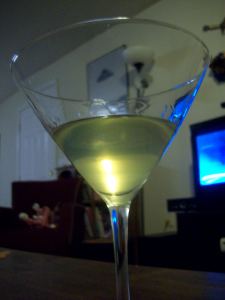 According to The The Savoy Cocktail Book (1930)
According to The The Savoy Cocktail Book (1930), this cocktail is “so-called because if there should happen to be an earthquake when you are drinking it, it won’t matter.” That is both a wonderful and terrible endorsement for a cocktail.
I’ll be honest — I’ not so sure I would make this drink again. It’s not that bad, but it’s not that special, either. I mean, how special can a few liquors thrown together really be? If you really want to get drunk that fast, you should just do shots.
There’s such a high proportion of absinthe in this that you’ll notice the anise more than anything else. However, if you pay attention, you’ll notice the robust flavor of the whiskey at the beginning of the drink, and then the more subtle notes of the gin as you swallow the liquid. And, of course, you’ll taste that heavy licorice taste throughout.
Making it is simple enough, anyway. Just shake the ingredients with ice and strain it into a martini glass. The type of whiskey isn’t specified, by the way. I used bourbon, because that’s the most common whiskey in cocktails, and it worked out well. Another good starting point would be Canadian whisky, as its smoothness and unobtrusiveness lends itself well to cocktails.
Now let’s get a little immature.
Monkey Gland
- 2 oz Gin
- 1 oz Orange Juice
- 2 dashes Grenadine
- 1 dash Absinthe
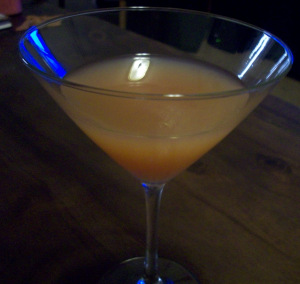 This is another old school cocktail, but its origins are a lot more amusing than most others. You see, there used to be this doctor. Dr. Serge Voronoff, we called him. Old Voronoff had an idea — an idea unlike any other. You see, Voronoff liked to graft monkey testicles onto the testicles of living, breathing, human men. Why? To combat the effects of aging, of course!
This is another old school cocktail, but its origins are a lot more amusing than most others. You see, there used to be this doctor. Dr. Serge Voronoff, we called him. Old Voronoff had an idea — an idea unlike any other. You see, Voronoff liked to graft monkey testicles onto the testicles of living, breathing, human men. Why? To combat the effects of aging, of course!
However, people were quick to turn this into an aphrodisiac, though Voronoff denied that the procedure had such effects — apparently he really knew his science when it came to monkey balls. Before long, severely misguided men were lining up around the block (think Phantom Menace lines) to put some monkey balls onto their own set to make them better lovers.
So, fellas, if you’ve ever felt insecure about your junk, don’t worry. I’m sure you’ve never felt so bad that you’ve wanted to graft monkey nuts onto your berries. And if you have, well, you clearly haven’t had enough to drink.
In any case, this long-forgotten cocktail commemorated this unfortunate spree of surgeries, and, truth be told, it’s not terrible. The grenadine provides a nice sweet counterpart to the anise flavor, all the while dancing on the flavorful citrus backdrop provided by the orange juice. Unfortunately though, the gin is all but unnoticeable. I might try this drink again in the future with vodka instead of gin to see if it makes much of a difference, but for now I think that the gin is irrelevant. I don’t taste it at all, not even as an aftertaste. That being said, the flavor is quite nice. I just think the more neutral vodka might be more appropriate than gin.
In any case, to make this just shake the ingredients with ice and strain it into a martini glass. Try not to make any obscene decisions while you drink it.
Last drink! Get excited!
Absinthe Kangaroo (Absinthe Martini)
- 2 oz Vodka
- 1 oz Absinthe
- Lime Twist
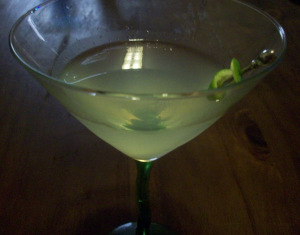 Kangaroo is another name for a Vodka Martini. Martini aficionados would no doubt prefer that you use it instead of “Martini,” which they would reserve to refer to their holy grail of gin and vermouth. Out of respect, I chose the term Kangaroo for this cocktail, though it certainly is very much inspired by the Martini blueprint — even though it contains neither gin nor vermouth.
Kangaroo is another name for a Vodka Martini. Martini aficionados would no doubt prefer that you use it instead of “Martini,” which they would reserve to refer to their holy grail of gin and vermouth. Out of respect, I chose the term Kangaroo for this cocktail, though it certainly is very much inspired by the Martini blueprint — even though it contains neither gin nor vermouth.
This is a very elegant and simple drink. The absinthe really shines here, and the vodka provides a smooth backdrop to add to the overall feeling of the drink. If you think you can take the sheer amount of booze in this drink, by all means, go for it.
Simply shake the liquid ingredients with ice and strain it into a martini glass. Twist the lime peel over the drink and drop it in. Isn’t that pretty?
Denouement
What have we learned? Well, I learned that despite my sophomoric intoxicated tendencies, I can be classy too. Sometimes, that knowledge is all you need to make it through the day.

